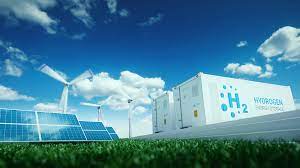After Russia’s invasion of Ukraine in March 2022 set off a rush for gas resources worldwide, Europe picked Africa as an alternative supply market for natural gas. European energy ministers and other political leaders toured North African countries and gas initiatives in both East and West Africa received renewed support.
Now, Europe is setting its sight on Africa’s yet-to-be-developed green hydrogen industry, in what appears to be an early race to build up clean energy resources, part of a major, continued transition away from fossil fuels.
European Union and individual countries and companies have begun making massive commitments to green hydrogen and other forms of green energy in Africa, including provisions for exports from the continent to serve Europe’s domestic needs.
The recent signing of a US$34 billion dollar agreement for a giant green hydrogen project in Mauritania is just one of those developments. On 8 March, an international consortium made up of German project developer Conjuncta, the UAE renewable energy giant Masdar, and Egyptian technology provider Infinity, signed a memorandum of understanding with the Mauritanian Ministry of Petroleum, Mines and Energy in a deal to produce up to 8 million tonnes of green hydrogen annually for the international market.
“It will have a strong link with Germany, both as a technology provider and as a potential supplier of green energy,” said Conjucta’s chief executive officer, Stefan Liebing, in a statement on the deal.
There have also been strategic partnerships with Kenya and Morocco for multi-million dollar green hydrogen investments.
On 1 March, the European Investment Bank’s vice president, Thomas Östros and Kenya’s National Treasury and Economic Planning cabinet secretary, Njuguna Ndung’u, signed a joint declaration on renewable clean hydrogen. As part of the agreement, EIB is to initially mobilise grants worth €1.8 million from the European Union and appraise possible loan financing for larger green hydrogen-related investments.
Kenya will help the bank’s energy and finance experts identify and develop new renewable energy projects and unlock the construction of hydrogen production infrastructure. “The new agreement between the EIB, the EU Bank, and Kenya will accelerate identification and investment in green hydrogen in Kenya and harness renewable energy to deliver affordable and sustainable energy,” said European Union ambassador to Kenya, Henriette Geiger.
In October 2022, the EU Commission also signed a pact with Morocco to invest millions in producing green hydrogen for export to Europe.
A 2022 EIB report, dubbed Africa’s extraordinary green hydrogen potential, projects the continent will reach an annual production capacity of 50 million tonnes of green hydrogen by 2035 at a competitive price of below $2 per kilogram. In a comparative analysis done by research firm Aurora Energy, the production of clean hydrogen in Germany will cost between $4.23-5.43 per kilogram by 2030.
It singled out importing hydrogen to Germany from Morocco, transported by ship as liquid hydrogen, as presenting the most competitive option by 2030 – with a projected price of $4.93 per kilogram.
Africa’s large potential capacity for green hydrogen production and the resultant competitive pricing has seen the continent referred to as the world’s new energy powerhouse.
However, the region will need the requisite infrastructure to not only manufacture at scale but also transport the fuel underground through a pipeline or via tankers onto ships bound for Europe. Despite the variances in costs due to transport distance, overall costs remain significantly cheaper than the option of domestic production in Europe.
“Hydrogen is going to be a global commodity. Once the infrastructure is available, pipelines will unleash the cheapest hydrogen import routes to Europe. However, even imports of hydrogen by ship – more expensive than pipelines – will be economically competitive with domestic production,” explained Dilara Caglayan, a senior associate at Aurora Energy Research.
Australia, Saudi Arabia and British firms are also showing a growing interest in Africa’s emerging green hydrogen sector. Australian group Fortescue Metals has its eyes on Kenya, South Africa and, lately, Namibia through its local subsidiary, Fortescue Future Industries.
The Saudi energy firm Acwa Power plans a $10 billion investment in partnership with South Africa’s Industrial Development Corporation (IDC), while Hive Hydrogen, the subsidiary of the British company Hive Energy, is in talks with South Africa’s Eastern Cape officials to pump $6 billion into the Nelson Mandela Bay area for green ammonia production. Ammonia is often regarded as the easiest way to transport clean hydrogen, with the ammonia converted to hydrogen at the destination.

 Iran Energy News Oil, Gas, Petrochemical and Energy Field Specialized Channel
Iran Energy News Oil, Gas, Petrochemical and Energy Field Specialized Channel



